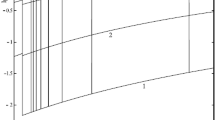Abstract
Highly nonadiabatic shock waves are formed at an early stage of a supernova explosion inside a stellar wind because of the large energy losses by direct radiation from the front. The properties of such waves are considered for velocities of (5−25)×103km s−1 and gas densities of 10−17−10−10 g cm−3. A critical energy flux going to “infinity” that separates two modes is shown to exist. If the flux is lower than the critical one, then energy losses cause even an increase in the post-shock temperature. An excess of the flux over its critical value results in an abrupt cooling and in a strong compression of the gas. For the flux equal to the critical one, the post-shock gas velocity matches the isothermal speed of sound. Approximate formulas are given for estimating the degree of gas compression and the post-shock radiation-to-gas pressure ratio at energy losses equal to the critical ones and for the limiting compression.
Similar content being viewed by others
References
S. I. Blinnikov and O. S. Bartunov, Astron. Astrophys. 273, 106 (1993).
R. A. Chevalier, Astrophys. J. 258, 790 (1982).
R. A. Chevalier and R. I. Klein, Astrophys. J. 234, 597 (1979).
S. W. Falk and W. D. Arnett, Astrophys. J., Suppl. Ser. 33, 515 (1977).
E. K. Grasberg, Baltic Astron. 3, 252 (1994).
E. K. Grasberg, V. S. Imshennik, and D. K. Nadyozhin, Astrophys. Space Sci. 10, 28 (1971).
E. K. Grasberg and D. K. Nadyozhin, Astron. Zh. 64,63 (1987) [Sov. Astron. 31, 31 (1987)].
V. S. Imshennik, Fiz. Plazmy 1, 202 (1975)[Sov. J. Plasma Phys. 1, 108 (1975)].
V. S. Imshennik, Zh. Éksp. Teor. Fiz. 42, 236 (1962).
V. S. Imshennik and Yu. I. Morozov, Astron. Zh. 46, 800 (1969) [Sov. Astron. 13, 628 (1969)].
V. S. Imshennik and Yu. I. Morozov, Zh. Prikl. Mekh. Tekh. Fiz., No. 2, 8 (1964).
I. A. Klimishin, Shock Waves in Stellar Envelopes (Nauka, Moscow, 1984).
Yu. I. Morozov, Zh. Prikl. Mekh. Tekh. Fiz., No. 4, 42 (1966).
D. K. Nadyozhin, Astrophys. Space Sci. 112, 225 (1985).
D. K. Nadyozhin, Preprint No. 1, ITÉF (Institute of Theoretical and Experimental Physics, Moscow, 1981).
M. A. Tsikulin and E. G. Popov, in Radiative Properties of Sock Waves (Nauka, Moscow, 1977).
Ya. B. Zel'dovich and Yu. P. Raizer, Physics of Shock Waves and High-Temperature Hydrodynamic Phenomena (Nauka, Moscow, 1966, 2nd ed.; Academic Press, New York, 1966).
Author information
Authors and Affiliations
Additional information
__________
Translated from Pis'ma v Astronomicheski\(\overset{\lower0.5em\hbox{$\smash{\scriptscriptstyle\smile}$}}{l} \) Zhurnal, Vol. 26, No. 9, 2000, pp. 676–682.
Original Russian Text Copyright © 2000 by Grasberg.
Rights and permissions
About this article
Cite this article
Grasberg, E.K. Shock waves with large energy losses by direct radiation from the front. Astron. Lett. 26, 582–588 (2000). https://doi.org/10.1134/1.1307892
Received:
Issue Date:
DOI: https://doi.org/10.1134/1.1307892



